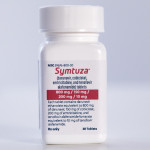A drug regimen containing Isentress (raltegravir), Intelence (etravirine) and Norvir (ritonavir)–boosted Prezista (darunavir) continues to work astonishingly well in a French clinical trial involving heavily treatment-experienced people living with HIV. About 86 percent of those using this potent regimen active against drug-resistant virus have undetectable viral loads after 48 weeks of treatment, report researchers from the Agence Nationale de Recherches sur le Sida et les Hépatites Virales (ANRS) 139 TRIO study team at the Fifth International AIDS Society (IAS) Conference on HIV Pathogenesis, Treatment and Prevention in Cape Town.
Isentress, Intelence and Prezista are three of the newest antiretrovirals (ARVs), initially approved specifically for treatment-experienced people living with HIV; both Isentress and Prezista are now also approved for treatment-naive patients.
Because these compounds—an integrase inhibitor, a non-nucleoside reverse transcriptase inhibitor (NNRTI) and a protease inhibitor (PI), respectively—were being evaluated in clinical trials around the same time, studies evaluating the use of all three agents together were not possible. However, because these three drugs have demonstrated effectiveness against HIV resistant to older ARVs, they were expected to perform well when used together.
Only now have researchers begun to understand exactly how much these drugs—especially when used in combination with each other—have to offer patients with a great deal of previous treatment experience under their belts.
Data from the 24-week TRIO study were reported at last year’s International AIDS Conference in Mexico City. The 48-week data were reported at IAS in Cape Town by Yazdan Yazdanpanah, MD, PhD, of the Centre Hospitalier de Tourcoing in Tourcoing, France.
The study enrolled 103 HIV-positive patients to take Isentress, Intelence and Norvir-boosted Prezista with an optional background regimen of nucleoside reverse transcriptase inhibitors (NRTIs) with or without Fuzeon (enfuvirtide).
Eighty-eight percent of the patients were male, and the average age was 45. The average viral load upon entering the study was 10,000 copies, and the average CD4 cell count was 255. Patients had been on ARV treatment for an average of 13 years.
As for pre-treatment resistance profiles, patients in TRIO had an average of four major PI mutations, five major NRTI mutations and one major NNRTI mutation in their HIV, which was evidence of significant drug resistance. Additionally, 96 percent and 65 percent of patients had between one and three HIV mutations conferring at least partial resistance to Prezista and Intelence, respectively. The authors also reported that 59 percent of the patients were using a background regimen that didn’t contain any ARVs that were fully active against their HIV.
Yet the results after nearly 12 months are remarkable. According to Yazdanpanah, 93 patients (90 percent) had viral loads below 50 copies after 24 weeks. Between weeks 24 and 48, only four patients experienced viral load rebounds while on this drug regimen, reducing the overall effectiveness rate to 86 percent.
Yazdanpanah and his colleagues also observed an average CD4 count increase of 99 cells after 24 weeks.
The regimen containing Isentress, Intelence and Norvir-boosted Prezista, Yazdanpanah said, was generally well tolerated. Serious adverse effects have been reported in 15 patients, but only four of these are believed to be related to the treatment regimen. One patient with a rash and fever discontinued treatment.
Significant increases in creatinine levels—a sign of muscle damage—were noted in 11 patients, and in four patients, sharp increases in the liver enzyme GGT were reported. However, none of these individuals has discontinued treatment.
Yazdanpanah said that the study is ongoing and that additional data from the final 96-week time point will be reported in the future.
Advertisement
Advertisement
Advertisement






Comments
Comments